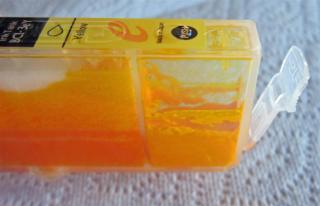Tom Hock
Getting Fingers Dirty
An original Canon BCI-3eY used in my iP6000D printer had about 1/4 of the ink in the reservoir turn solid, or to a gel. The ink in the sponge seems normal and will wick into a tissue if touched. This tank had never been refilled, and was all original Canon ink. I don't know the history of this tank. It may have been given to me by my brother, or I could have bought it in a thrift shop or yard sale, or it may have been removed from an old printer with the top vent open for some time. I seldom use new ink tanks because I refill, but if I come across originals for a low price I buy them just to get the Canon tanks. If this had been a refilled tank I would have suspected the ink, but this is original Canon, and my understanding is there is no expiration date on original Canon tanks. All my tanks are stored at room temperature.
The strange thing is the printer was working fine last night when the yellow low ink indicator came on. This morning I put another tank in and noticed the problem. I don't know how the low ink indicator even worked since the prism was covered with ink (or a solid or gel). Also, the print head nozzels didn't plug-up. The printer is still printing well with the replacement tank.
Just thought this was interesting and wondered if any one else ever noticed this or may know the reason.

The strange thing is the printer was working fine last night when the yellow low ink indicator came on. This morning I put another tank in and noticed the problem. I don't know how the low ink indicator even worked since the prism was covered with ink (or a solid or gel). Also, the print head nozzels didn't plug-up. The printer is still printing well with the replacement tank.
Just thought this was interesting and wondered if any one else ever noticed this or may know the reason.


 Hi Tom,
Hi Tom,